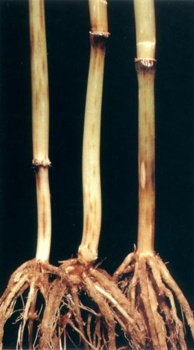Diseases
Bipolaris sorokiniana (Sacc.) Shoemaker - Common root rot.
Taxonomic position.
Class Hyphomycetes, order Hyphomycetales, family Dematiaceae, genus Bipolaris.Synonyms.
Helminthosporium sativum Pammel, C.M. King et Bakke,Teliomorph Cochliobolus sativus (Ito et Kurib.) Drechsler ex Dastur.
Biological group.
Root diseases of grain crops.Morphology and biology.
Mycelium is septate, deep olive-brown. Conidiophores are solitary or in small groups, septate, straight to flexuous, sometimes geniculate, dark-brown, 50-150 X 6.0-8.5 microns. Conidia are dark-olive or dark-brown to black, fusiform to broadly ellipsoidal, straight to slightly curved, with 2-13 distoseptae, 30-134 X 12-30 microns in size; germinate polarly (from two marginal cells). Ascomata are pseudothecioid, dark-brown, ampuliform or spherical, 370-530 X 340-470 microns. Asci are numerous, fusiform or cylindrical with short peduncle, 110-220 X 32-45 microns, with 1-8 (more often with 4-8) spores. Ascospores are filiform, 6-14 septate, hyaline to light-yellow, 160-360 X 6.0-9.0 microns. Chlamydospores form on substrate mycelium, solitary or in short chains, round or elongated, 150-200 X 60-80 microns, thick-walled. In winter, fungus survives by mycelium, conidia and chlamydospores. In spring the primary infection of plants is carried out by introduction of mycelium and germs of conidia in tissue of roots and stems. In summer fungus develops in conidial stage, damaging roots, leaves, and grain. In soil conidia survive up to 5 years. The mycelium (with lack of mineralization) survives up to 2-3 years; microorganisms-antagonists fast displace mycelium from plant debris.Distribution.
Europe, Asia, Africa, America, Australia. In the former USSR it is known from the droughty districts of the European part, South Ural, Altai, West and East Siberia.Symptoms.
On coleoptile, primary and secondary roots, epicotyl, knot of tillering, basal part of stem and leaf vaginas there are, at first, small points, spots or stripes of light brown color, which gradually become dark-brown and coalesce. During shooting stage, and later, browning of the basal part of stem and lower internode is observed. The strongly damaged plants retard in growth, do not form ears or form small ears with shriveled grain or without grains (white-stem or shriveling of ear).Ecology.
The disease incidence is higher with a shortage, or sharp fluctuations, of soil humidity; with a rise in air and soil temperatures during initial phase of vegetation that results in breaking water balance; and weak formation of secondary roots. The fungus grows at 6-36°C (optimum 19-26°C). The mycelium and conidia survive at low temperatures (up to 40°C). Soil with mildly alkaline to neutral (pH 6-7) response is favorable for the fungus. Minimum soil humidity necessary for infection of plants is 20-40%; optimum is 60-80% of complete soil water storage. Conidia spread by air.Economic significance.
The fungus causes the greatest damage to spring wheat in zones of unstable humidity; as well as to barley, rye and oat. It also damages Elytrigia, Poa, Festuca, Bromus, Setaria, Lolium. Protection measures include cultivation of drought- and disease-resistant varieties, removal of debris and host plants, soil treatment directed at humidity reservation, optimal crop rotation, optimal terms of sowing for zones, application of phosphor-potassium- and micro-fertilizers, seed dressing.Reference citations:
Chulkina V.A. The integrated protection of summer wheat and barley from common root rot in West Siberia. Nauchno-tekhnicheskii byulleten.. Novosibirsk, 1977, 19. pp. 3-13 (in Russian).Hatskevich L.K., Benken A.A., Mudrov V. I.. Root rots of summer wheat in Chulimo-Enisei forest-steppe of Krasnoyarsk Territory. Trudy Vsesoyuznogo n.-i. in-ta zashchity rastenii. Leningrad. 1977, pp. 21-30 (in Russian).
Hatskevich L.K., Nesterov A.H. Pathogen complex of root rots of summer wheat in South Ural. Mikologiya i fitopatologiya. 1994, T. 28, 6, pp. 71-75 (in Russian).
Ishkova T.I., Berestetskaya L.I., Gasich E.L., Levitin M.M., Vlasov D. J. Diagnostics of main diseases of grain crops. St. Petersburg, 2002, 68 pp. (in Russian).
Korshunova A.F., Chumakov AE., Shchekochikhina R.I. Protection of wheat from root rots. -Leningrad, Kolos, 1976, 184 pp. (in Russian).
Korshunova A.F., Tupenevich S.M., Kraeva G.A., Gorodilova L.M. Root rots of summer wheat. - Leningrad, Kolos, 1974, 64 pp. (in Russian).
Tumanova T.D. The basic and secondary pathogens of root rot in east districts of the Orenburg Region and their features. Zashchita rastenii ot vreditelei i boleznei. Trudy LSKhA, 1981, 188, pp. 57-60 (in Russian).


